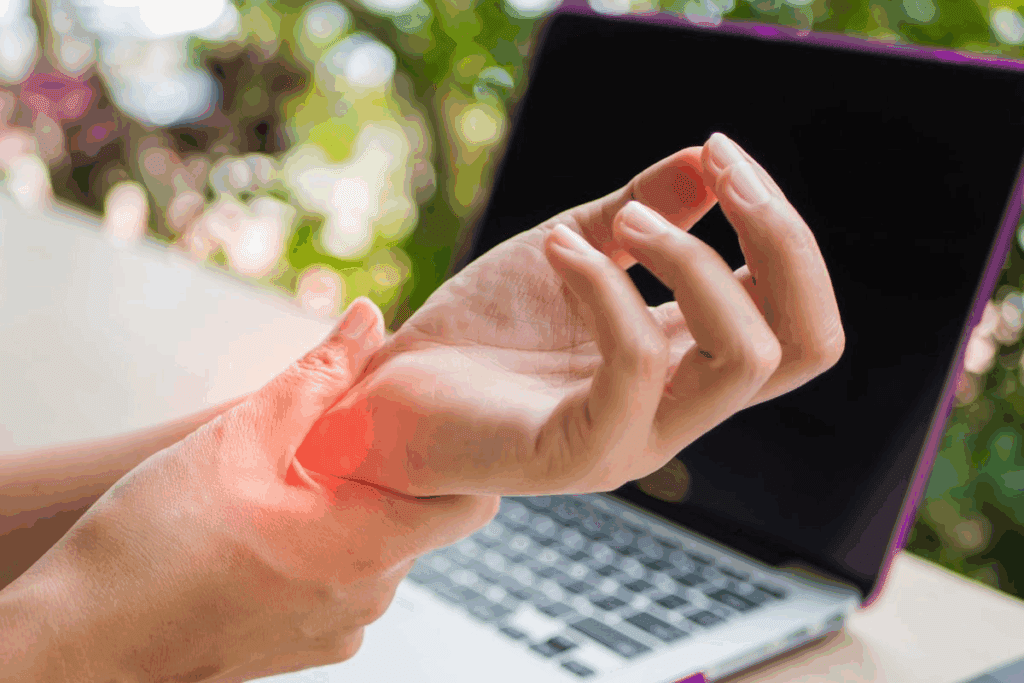Last Updated on November 4, 2025 by mcelik

This illustration details the anatomy of the carpal tunnel in the human hand, highlighting the median nerve, flexor tendons, and the surrounding bones and ligaments, helping explain the causes of carpal tunnel night pain.
Nighttime symptoms can really hurt, causing numbness and discomfort in the hands. We’ll look into why carpal tunnel night pain gets worse. We’ll also talk about ways to make life better.
This illustration details the anatomy of the carpal tunnel in the human hand, highlighting the median nerve, flexor tendons, and the surrounding bones and ligaments.
| Structure | Description |
| Median Nerve | A nerve that controls sensation and movement in the hand. |
| Carpal Tunnel | This illustration details the anatomy of the carpal tunnel in the human hand, highlighting the median nerve, flexor tendons, and the surrounding bones and ligaments. |
| Transverse Carpal Ligament | A ligament that forms the roof of the carpal tunnel. |
Early signs often show up at night or during activities that involve repetitive hand movements.
It’s key to spot these symptoms early to manage them well and avoid lasting damage.
People with carpal tunnel often feel worse at night. Nighttime symptoms like pain, numbness, and tingling in the hands are common. These symptoms usually get worse in the late evening and early morning.
During the day, symptoms can change based on how active you are and how you hold your wrists. Doing the same thing over and over or holding your wrists in certain ways can make symptoms worse.

There are many reasons why carpal tunnel symptoms follow a day-night pattern. Fluid redistribution during sleep is a big factor. When you lie down, fluid can move and put more pressure on the carpal tunnel.
Also, wrist positioning during sleep can make this pressure worse. Many people unknowingly bend or straighten their wrists while sleeping. This can press on the median nerve.
It’s important to remember that everyone’s symptoms are different. Some people might feel worse at night, while others might feel worse during the day. This depends on what they do and their job.
Knowing when and why symptoms happen is key to managing them. By understanding these patterns, people can take steps to feel better.
Many people find their carpal tunnel symptoms get worse at night. This is due to several reasons. Knowing these can help manage and reduce nighttime pain.
When we sleep, our body redistributes fluids. This can put more pressure on the median nerve. This swelling in the wrist can make carpal tunnel symptoms worse.
How we hold our wrists at night affects carpal tunnel symptoms. If we flex or extend our wrists, it can press on the median nerve. This can lead to more pain and numbness.
During the day, we’re often distracted from carpal tunnel pain. At night, without these distractions, the pain is more noticeable. This can disrupt our sleep.
The median nerve goes through the carpal tunnel in the wrist. Fluid shifts and wrist positioning can increase pressure on this nerve. This makes carpal tunnel symptoms worse at night.
| Factors Contributing to Night Pain | Description | Impact on Symptoms |
| Fluid Redistribution | Fluid shifts during sleep, potentially causing swelling | Increased pressure on the median nerve |
| Wrist Positioning | Flexing or extending the wrist during sleep | This illustration details the anatomy of the carpal tunnel in the human hand, highlighting the median nerve, flexor tendons, and the surrounding bones and ligaments. |
| Reduced Distractions | Lack of daytime distractions at night | Increased awareness of pain |
Understanding these factors can help reduce carpal tunnel night pain. Adjusting sleep positions, using wrist splints, and relaxing before bed can help.

Many people with carpal tunnel syndrome wake up to find their hands numb and painful. This isn’t just because of how they sleep. It’s because of how carpal tunnel syndrome works.
This illustration details the anatomy of the carpal tunnel in the human hand, highlighting the median nerve, flexor tendons, and the surrounding bones and ligaments.
There are ways to ease morning symptoms. Doing gentle wrist exercises, like wrist extensions and flexions, can help. Also, using a wrist splint at night can help keep wrists in the right position and reduce numbness in the morning.
Starting your day with exercises and stretches can help manage carpal tunnel symptoms. Begin with simple stretches and gradually add more activity. This can help lessen morning stiffness.
| Activity | Purpose | Duration |
| Gentle Wrist Extensions | Reduce stiffness and improve flexibility | 5 minutes |
| Wrist Splint Adjustment | Ensure proper wrist alignment | N/A |
| Morning Stretching | Improve overall flexibility and reduce muscle tension | 10 minutes |
Repetitive motion can make carpal tunnel symptoms worse. Doing the same thing over and over can strain your wrist and hand. This puts more pressure on the median nerve.
Good workplace ergonomics are key to managing carpal tunnel. A well-set workspace can help reduce strain and pain. Make sure your keyboard is in front of you, wrists are straight, and your chair supports your back.
| Adjustment | Description | Benefit |
| Monitor Height | Position monitor directly in front, at a distance of about 20-25 inches, and at a height that allows the top of the screen to be at eye level or slightly below. | Reduces strain on the neck and promotes good posture. |
| Keyboard and Mouse Position | Keep keyboard directly in front of the body, wrists straight, and mouse close to the body and at the same height as the keyboard. | Minimizes strain on wrists and hands. |
| Chair Height and Support | Adjust chair height so feet are flat on the floor or on a footrest, and ensure adequate lumbar support. | Promotes good posture and reduces strain on the back. |
It’s crucial to take breaks during work to manage carpal tunnel symptoms. These breaks let you rest your hands and wrists. They also give you a chance to stretch and change positions, which can help reduce strain.
Daily activities can make carpal tunnel symptoms worse by evening. We often don’t notice the strain on our wrists during the day. But by night, the pain, numbness, or tingling becomes more noticeable.
Cumulative strain is the gradual wear and tear on muscles, tendons, and nerves. For carpal tunnel syndrome, this strain increases pressure on the median nerve. Repetitive tasks, like typing or using vibrating tools, add to this strain. As the day goes on, this can cause inflammation and irritation, leading to carpal tunnel symptoms.
There are ways to ease evening symptoms. Stretching exercises can reduce wrist and hand tension. Simple stretches, like extending the wrist or rotating the hand, can be done all day to lessen strain. Also, proper wrist care, like keeping wrists neutral and taking breaks, helps.
Other strategies include using cold or heat therapy to reduce pain and inflammation. Relaxation techniques, like deep breathing or meditation, can also help manage stress. By adding these to your daily routine, you can lessen symptoms and improve your life quality.
Daily activities greatly affect how bad carpal tunnel symptoms are. Knowing this helps manage symptoms better. Activities that make you move your wrist a lot can make symptoms worse. Changing these activities and using the right tools can help manage symptoms.
Activities that make you move your hands or wrists a lot are bad for carpal tunnel. These include:
Repetitive motion is a big problem for carpal tunnel symptoms. Changing these activities can help lessen symptoms.
Changing how you do daily activities can help with carpal tunnel symptoms. Ways to do this include:
Using these activity modification strategies can help ease some of the pressure on your wrists.
Using the right tools and aids can really help with carpal tunnel symptoms. Examples are:
These tools and aids can lessen the strain of daily tasks. This can help reduce carpal tunnel symptoms.
This illustration details the anatomy of the carpal tunnel in the human hand, highlighting the median nerve, flexor tendons, and the surrounding bones and ligaments.
Changes in temperature can affect nerves and how we feel pain. Cold weather can make muscles and tendons tighten, putting more pressure on the median nerve. A study found that cold can slow down nerve signals, making symptoms worse.
But, some people might feel better in warmer weather. Yet, this can differ a lot from person to person.
Changes in barometric pressure, linked to weather, can also affect carpal tunnel symptoms. Research shows these pressure changes can make tendons and joints expand and contract. This can irritate the median nerve.
One patient shared, “
Before a storm, I always feel more numbness and pain in my hands.
” This story backs up the idea that barometric pressure changes can make symptoms worse.
Seasonal changes bring different temperatures and barometric pressures. They also change how active we are and how we manage carpal tunnel. For example, cold months might mean less activity that could help symptoms.
Knowing how weather and environment affect carpal tunnel pain helps us manage it better. We can adjust our daily activities based on the weather or use specific strategies to deal with temperature and pressure changes.
Hormonal changes can make carpal tunnel syndrome symptoms worse. We’ll look at how different hormonal shifts affect carpal tunnel, especially during big life events and conditions.
Managing carpal tunnel syndrome during pregnancy involves making lifestyle changes and, if needed, medical treatments. Wearing a wrist splint at night can help ease symptoms.
Hormone replacement therapy (HRT) might help manage menopause symptoms, including carpal tunnel syndrome for some women. But, deciding on HRT should be done with a healthcare provider, considering the benefits and risks.
It’s important to understand how hormonal changes affect carpal tunnel syndrome. By knowing how different hormonal shifts impact symptoms, people can work with their healthcare providers to create effective treatment plans.
Choosing the right sleep position is key. Sleeping with your wrists straight can ease pressure on the median nerve. Try to avoid bending your wrists up or down, as it can make symptoms worse.
Sleep Position Tips:
Wearing a wrist splint at night can help manage symptoms. It keeps your wrist straight, which reduces nerve pressure.
| Bracing Option | Description | Benefits |
| Wrist Splints | Custom or off-the-shelf splints that hold the wrist in a neutral position. | Reduces pressure on the median nerve, alleviates nighttime symptoms. |
| Soft Wrist Supports | Soft, flexible supports that provide gentle wrist stabilization. | Comfortable for long-term wear, suitable for mild symptoms. |
Having a pre-sleep routine can help your body relax. Activities like stretching, meditation, or a warm bath can relax your muscles and get you ready for sleep.
Pre-Sleep Routine Ideas:
The right pillow and mattress can also help with carpal tunnel symptoms at night. A supportive mattress and pillows that keep your spine aligned can reduce strain on your wrists.
Look for pillows and mattresses that support your body well and keep your spine straight. This can help ease wrist pressure and symptoms.
When carpal tunnel syndrome gets worse, especially at night, you need medical help. Severe pain can mess up your sleep and daily life. You need a good plan to manage it.
Doctors often start with medicine to ease nighttime pain. Over-the-counter pain relievers like ibuprofen or acetaminophen can help. Sometimes, prescription medications like gabapentin or pregabalin are needed for nerve pain.
| Medication Type | Examples | Primary Use |
| Over-the-counter pain relievers | Ibuprofen, Acetaminophen | Pain and inflammation relief |
| Prescription nerve pain medications | Gabapentin, Pregabalin | Nerve pain management |
Corticosteroid injections are also a good choice for severe carpal tunnel. They can shrink swelling and ease pressure on the median nerve. This helps a lot with nighttime pain.
Benefits of corticosteroid injections include:
If other treatments don’t work, surgical intervention might be needed. Carpal tunnel release surgery cuts the ligament that presses on the median nerve. This can really help.
Key considerations for surgery include:
For those with carpal tunnel syndrome, nighttime can be tough. But, there are natural remedies that can help. These symptoms can mess with your sleep and life quality. Luckily, many natural and alternative therapies can ease these issues.
Adding simple stretches to your evening can ease carpal tunnel symptoms. Wrist flexion stretches and median nerve glides are great. To do a wrist flexion stretch, pull your hand back and up for 15-30 seconds. Repeat 3-5 times.
Some herbal remedies and supplements can fight inflammation and ease carpal tunnel symptoms. Turmeric, with curcumin, is anti-inflammatory. Omega-3 fatty acids and vitamin B6 are also good.
| Supplement | Potential Benefits |
| Turmeric/Curcumin | Reduces inflammation |
| Omega-3 Fatty Acids | Anti-inflammatory effects |
| Vitamin B6 | Nerve health support |
Cold and heat therapy can help with carpal tunnel symptoms. Cold reduces inflammation, while heat relaxes muscles and boosts circulation. Switching between them can offer the best relief.
Acupuncture and massage therapy can also help. Acupuncture uses thin needles to stimulate healing and reduce pain. Massage relaxes muscles and improves wrist movement.
By using these natural and alternative remedies, you can lessen nighttime carpal tunnel symptoms. This can improve your life quality.
We can ease carpal tunnel syndrome symptoms with simple lifestyle changes. Making a few daily habit adjustments can greatly reduce discomfort. This makes life easier for those dealing with carpal tunnel syndrome.
Eating a balanced diet is key to managing inflammation. This can help lessen carpal tunnel syndrome symptoms. Adding anti-inflammatory foods to our meals is beneficial. Some good options include:
It’s also wise to cut down on foods that can trigger or make inflammation worse. Avoid processed foods, sugary snacks, and foods high in salt.
Regular exercise keeps our wrists and hands flexible and strong. This can lower the risk of carpal tunnel syndrome. But, we should pick exercises that don’t strain our wrists and hands. Good exercises include:
Before starting any new exercise, it’s smart to talk to a healthcare professional. This is especially true if you’re dealing with severe carpal tunnel syndrome symptoms.
High stress levels can make muscle tension worse, which can hurt carpal tunnel syndrome symptoms. Using stress reduction techniques can help. Some effective methods include:
By making these lifestyle changes, people can lessen carpal tunnel syndrome symptoms. This improves their overall quality of life.
Knowing when to get medical help for carpal tunnel symptoms is key. Some discomfort is okay, but certain signs mean you need to see a doctor right away.
There are symptoms that mean you should go to the doctor fast. These include:
If you’re feeling any of these, see a doctor fast. Getting help early can stop long-term damage and help your treatment work better.
Your doctor might suggest different tests to check how bad your carpal tunnel is. These could be:
These tests help your doctor see how bad the nerve compression is and decide on treatment.
Finding a specialist who knows a lot about carpal tunnel is important. You might want to see:
Choosing the right specialist means you get care that fits your needs. Ask about their experience and treatment plans when you first meet them.
Understanding when to get medical help and what to expect from tests can help you manage your carpal tunnel better.
Managing carpal tunnel syndrome needs a mix of understanding its causes, making lifestyle changes, and using treatments. This approach helps reduce pain and improves life quality. It’s a way to tackle carpal tunnel pain effectively.
It’s key to watch daily activities, sleep positions, and health. Making smart choices about work ergonomics, exercise, and stress can help. Also, using bracing at night and setting up a good sleep routine can ease pain.
Combining these methods and getting medical help when needed helps control carpal tunnel syndrome. This way, people can live their lives without much pain. We stress the need for a proactive approach to manage pain and keep daily activities going smoothly.
This illustration details the anatomy of the carpal tunnel in the human hand, highlighting the median nerve, flexor tendons, and the surrounding bones and ligaments.
Symptoms get worse at night because of fluid changes during sleep. Wrist position and less distraction from pain also play a role. This leads to more pressure on the median nerve.
To manage night pain, try sleeping in the right position. Use a brace at night. Also, adjust your pillow and mattress to feel better.
Yes, natural remedies include stretches before bed. Herbal supplements and cold or heat therapy can help. Acupuncture and massage also offer relief.
Yes, making lifestyle changes can help. Eating right, exercising, managing weight, and reducing stress can all help reduce symptoms.
Seek medical help if you have severe pain, numbness, or tingling. If symptoms get worse over time, get checked out. Tests and a specialist can guide treatment.
For severe pain, doctors might prescribe medication. Corticosteroid injections can also help. Surgery might be needed if other treatments don’t work.
Hormonal changes, like during pregnancy or menopause, can make symptoms worse. Thyroid conditions can also affect symptoms.
Yes, weather and environment can affect pain. Temperature changes and barometric pressure can make symptoms worse. Some people feel pain more in certain weather.
Change activities that might hurt your wrist. Use tools and aids for tasks. These changes can help lessen symptoms.
Subscribe to our e-newsletter to stay informed about the latest innovations in the world of health and exclusive offers!